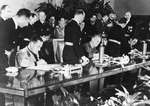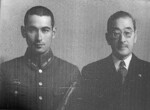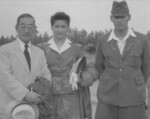Saburo Kurusu
| Surname | Kurusu |
| Given Name | Saburo |
| Born | 6 Mar 1886 |
| Died | 7 Apr 1954 |
| Country | Japan |
| Category | Government |
| Gender | Male |
Contributor: C. Peter Chen
ww2dbaseSaburo Kurusu was born into a family of high standing in Yokohama, Japan in 1883. He graduated from Tokyo Commercial College (now Hitotsubashi University) in 1909. He passed the test for diplomatic service in 1909 and began his career in 1910. Between 1914 and 1920, he worked in Chicago, Illinois, United States as a member of the Japanese Consul. He met and married the American woman Alice Jay Little, with whom he would have four children. In the 1920s and 1930s, he saw service in Chile, Italy, Germany, Peru, and Belgium, in addition to postings within Japan. On 27 Sep 1940, he signed the Tripartite Pact, an assignment that would seal his reputation for the Americans despite of his own reservations regarding the prospects of Japan being entangled in the conflict in Europe. After being recalled to Japan, was known for his stance against provoking war with western powers. Because Minister of Foreign Affairs Shigenori Togo did not have full trust in Ambassador Kichisaburo Nomura, Togo sent Kurusu to the United States to discuss peace alongside of Nomura. On 26 Nov, US Secretary of State Cordell Hull presented them with a set of non-negotiable demands for Japan to withdraw all troops from China and to sever relations with Germany and Italy, leading to Tokyo firmly embark on the decision to go to war. This decision was not made known to Kurusu and Nomura, but in the Americans perspective they were considered as deceitful for continuing the discussion all the way through the start of the Pacific War. In the afternoon of 7 Dec 1941, Kurusu and Nomura delivered Japan's declaration of war after the Pearl Harbor attack had already taken place, thus further damaging his standing with his American colleagues. He was interned at Hot Springs, Virginia, United States between Dec 1941 and Jun 1942, at which time he was transported to Mozambique aboard passenger liner Gripsholm. He spotted US Ambassador to Japan Joseph Grew at the docks, who was preparing to board Gripsholm for his return to the United States; the two diplomats (along with Nomura) removed their hats in mutual respect to each other. Kurusu was publicly lauded for his attempts to negotiate with the Americans against all odds, even if he had failed to secure peace. Throughout the course of the war, Kurusu continued his work with the Foreign Ministry. In a statement in Nov 1942 he insisted that the war Japan engaged in was one to free Asia of its western colonial empires. He used China as an example: "What I wish to stress especially at this time is that although the U.S. and Britain were always professing friendship to China, but what they are really after is China-that is Chinese territory and resources and not the Chinese people themselves." He insisted that Japan had only gone to war after all means to maintain peace in the Pacific were exhausted. His Chicago-born son Captain Ryo Kurusu, a Japanese Army pilot, died in Feb 1945 when he was struck by aircraft propellers at an airfield; while it was likely to be an accident, some speculated suicide. After the war, Kurusu was not prosecuted by the Allied military tribunal. He became a professor at Tokyo University and lived in a country estate in Karuizawa in central Japan with his wife. He passed away in 1954.
ww2dbaseSources:
Eri Hotta, Japan 1941
Wikipedia
Last Major Revision: Jul 2014
Saburo Kurusu Interactive Map
Photographs
 |  |  |  |
Saburo Kurusu Timeline
| 6 Mar 1886 | Saburo Kurusu was born in Yokohama, Japan. |
| 15 Nov 1941 | Saburo Kurusu arrived in the United States. |
| 17 Nov 1941 | Japanese special envoy Kurusu Saburo arrived in Washington DC and met with US Secretary of State Cordell Hull. |
| 20 Aug 1942 | Saburo Kurusu arrived in Japan. |
| 17 Feb 1945 | Captain Ryo Kurusu, son of Japanese diplomat Saburo Kurusu, was killed in an accident on the ground at an airfield. |
| 7 Apr 1954 | Saburo Kurusu passed away. |
Did you enjoy this article or find this article helpful? If so, please consider supporting us on Patreon. Even $1 per month will go a long way! Thank you. Share this article with your friends: Stay updated with WW2DB: |
Visitor Submitted Comments
21 Jul 2014 06:52:04 AM
I have read the daily postion on this site for over 2 years. This posting, along with many others, are unfortunately, a continuation of twisting of facts to support denial by the citizenry of Japan to accept responsibility for the actions of their country. This is not a database of facts. If the site owner is remotely interested in be honest with his readers he will retitle it "WWII Editorialized Database." This is my last visit.
9 Sep 2015 11:18:41 AM
Responding to the question on 2/28/2012: Do you actually know what holocaust means? He was Japanese diplomat, not a German. He did not of course involve in the holocaust.
Responding to the question on 7/21. While I do not believe this entry on Kurusu was well-written, I have to disagree with your comment. If you read the articles/books by Barnard Baruch, Stanley E. Jone's, and President Hoover's "agent" Desvernine, you will find out that Kurusu engaged in informal diplomacy to avert the war until at the last minute (and after formal negotiations needed with Japan rejecting the Hull Note in November). Baruch was to meet with FDR on 12/10 after his first meeting with him on 12/3 (I think, it could be 1st, I do not recall right now). So in this case, I think it is you who want to portray Japanese in a simplistic way and ignore/overlook evidence. Learning something new may be especially painful to those who refuse to see the truth.
All visitor submitted comments are opinions of those making the submissions and do not reflect views of WW2DB.
» The Tripartite Pact
» Attack on Pearl Harbor
Related Books:
» Japan 1941: Countdown to Infamy
» Japan 1941: Countdown to Infamy
» Pearl; December 7, 1941
- » 1,150 biographies
- » 337 events
- » 43,917 timeline entries
- » 1,241 ships
- » 350 aircraft models
- » 207 vehicle models
- » 375 weapon models
- » 123 historical documents
- » 260 facilities
- » 470 book reviews
- » 28,546 photos
- » 432 maps
Captain Henry P. Jim Crowe, Guadalcanal, 13 Jan 1943
Please consider supporting us on Patreon. Even $1 a month will go a long way. Thank you!
Or, please support us by purchasing some WW2DB merchandise at TeeSpring, Thank you!
28 Feb 2012 11:26:51 AM
question: was he ever involved in the holocaust?